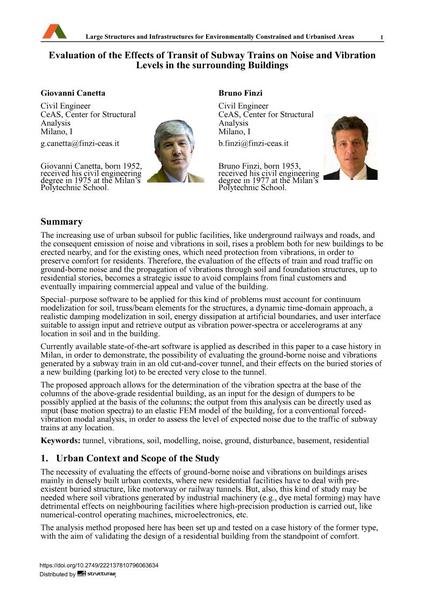Evaluation of the Effects of Transit of Subway Trains on Noise and Vibration Levels in the surrounding Buildings

|
|
|||||||||||
Bibliographic Details
| Author(s): |
Giovanni Canetta
Bruno Finzi |
||||
|---|---|---|---|---|---|
| Medium: | conference paper | ||||
| Language(s): | English | ||||
| Conference: | IABSE Symposium: Large Structures and Infrastructures for Environmentally Constrained and Urbanised Areas, Venice, Italy, 22-24 September 2010 | ||||
| Published in: | IABSE Symposium Venice 2010 | ||||
|
|||||
| Page(s): | 748-749 | ||||
| Total no. of pages: | 8 | ||||
| Year: | 2010 | ||||
| DOI: | 10.2749/222137810796063634 | ||||
| Abstract: |
The increasing use of urban subsoil for public facilities, like underground railways and roads, and the consequent emission of noise and vibrations in soil, rises a problem both for new buildings to be erected nearby, and for the existing ones, which need protection from vibrations, in order to preserve comfort for residents. Therefore, the evaluation of the effects of train and road traffic on ground-borne noise and the propagation of vibrations through soil and foundation structures, up to residential stories, becomes a strategic issue to avoid complains from final customers and eventually impairing commercial appeal and value of the building. Special–purpose software to be applied for this kind of problems must account for continuum modelization for soil, truss/beam elements for the structures, a dynamic time-domain approach, a realistic damping modelization in soil, energy dissipation at artificial boundaries, and user interface suitable to assign input and retrieve output as vibration power-spectra or accelerograms at any location in soil and in the building. Currently available state-of-the-art software is applied as described in this paper to a case history in Milan, in order to demonstrate, the possibility of evaluating the ground-borne noise and vibrations generated by a subway train in an old cut-and-cover tunnel, and their effects on the buried stories of a new building (parking lot) to be erected very close to the tunnel. The proposed approach allows for the determination of the vibration spectra at the base of the columns of the above-grade residential building, as an input for the design of dumpers to be possibly applied at the basis of the columns; the output from this analysis can be directly used as input (base motion spectra) to an elastic FEM model of the building, for a conventional forced- vibration modal analysis, in order to assess the level of expected noise due to the traffic of subway trains at any location. |
||||
| Keywords: |
modelling basement soil noise vibrations ground disturbance tunnel residential
|
||||
